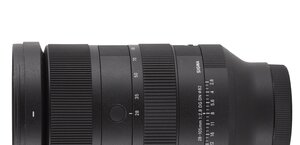Panasonic G X VARIO 12-35 mm f/2.8 ASPH. P.O.I.S
4. Image resolution
Let’s check how the tested lens compares here. The graph below presents its performance in the frame centre.

Please Support UsIf you enjoy our reviews and articles, and you want us to continue our work please, support our website by donating through PayPal. The funds are going to be used for paying our editorial team, renting servers, and equipping our testing studio; only that way we will be able to continue providing you interesting content for free. |
- - - - - - - - - - - - - - - - - - - - - - - - - - - - - - - - - - - - - - - - - - - - - - - -
It would be difficult to find here any reason to complain. Starting from f/4.0 aperture the lens’s performance is perfectly even and you can hardly distinguish particular focal lengths (within the margin of error). What’s more, by that f/4.0 we get MTFs as high as 80 lpmm so only slightly worse that those reached by the best ‘primes’ and, at the same time, higher than those of ‘pancake’ lenses. The differences between particular focal lengths are visible only at the maximum relative aperture – the worst result you get at 12 mm and the best at 23 mm. Fortunately even that worst result is good – situated safely above the decency level. In the frame centre the tested Panasonic doesn’t have any weak points at all – a round of applause!
Let’s check now whether there are any weaknesses on the edge of the frame.

One glance at the graph and you know that there is one weak point there – it is the combination of the maximum relative aperture and 35 mm focal length. The result, reached there, is a bit below the decency level, set by us in this test. Fortunately at other focal lengths the situation is much better and the results, even by f/2.8, can exceed 50 lpmm. On stopping down the lens to f/4.0 all focal lengths can reach as high as about 60 lpmm so images, provided by the tested instrument, are of good quality.
It’s worth noticing how much you can gain if you progress from a typical kit lens, e.g. the Panasonic G X VARIO PZ 14–42 mm f/3.5–5.6 ASPH. P.O.I.S. to the Panasonic 12-35 mm. The former barely exceeded 60 lpmm in the frame centre and at the best focal length and on the edge it never reached anything higher than 50 lpmm. You must admit the benefit is huge.
Traditionally at the end we present crops of our testing chart, taken from JPEG files saved along RAW files which were used for the analysis above.
 |






